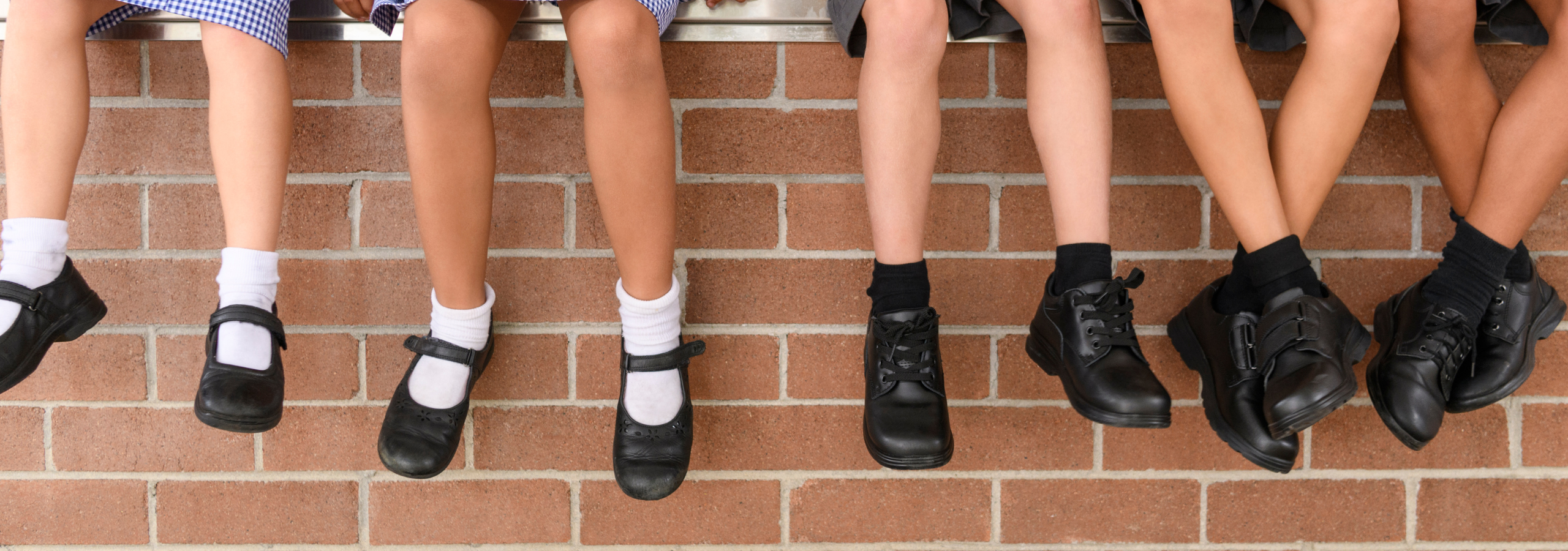
Gibbs Top Tips for Buying School Shoes
Gibbs of Spalding is one of the oldest independent, family run shoe shops in the country. Trading in Spalding since 1908 at our shop at 22 Hall Place, Spalding. Having fitted of generations of Spalding families with their school shoes, our experienced staff pride themselves on the service we offer. The store is now run by Emma, the 5th generation of the family to have taken on the business. Her degree in footwear design and her foot care qualifications give her a unique understanding of the world of shoes, feet and the long-term benefits of fitted shoes for growing feet.
Feet are only given a thought when they hurt. There is no doubt that from birth to early teens feet are at their most vulnerable. In fact, there are 26 bones in the foot and they do not completely ossify (harden) until around the age of 18. Our staff in both Gibbs of Ely and Gibbs of Spalding are always here to provide expert fitting assistance in store, or alternatively you can Shop Here for our online range of school shoes.
Useful Pointers
Have feet measured by a qualified fitter
Don't be afraid to ask what qualification the staff have attained in your shoe shop. Both feet should always be measured for size and width, because one foot may be different from the other. The larger foot usually dictates the size needed.
A fitting gauge is merely a guide
Fitting gauges all vary in calibration – no two gauges will measure the same. Sizes and fittings vary dependent on style, country of origin, manufacturer etc. There is no standardisation of shoe sizing in the UK - that is why a qualified shoe fitter is so important to interpret the correct shoe for the shape of the foot. What it says on the fitting gauge may not be the size or fitting you actually require, it'ss only a starting point.
A final assessment should be made whilst standing
Feet may be 'measured' sitting or standing and foot gauges are calibrated accordingly, but the final assessment should be made whilst standing (secondary fit), as the feet spread when standing weight is applied.
Buy footwear made of natural materials
Buy footwear made of natural materials such as leather, cotton etc, as these materials breathe and mould to your foot. Man-made materials such as plastic make feet perspire and the shoes return to their original shape. This can cause fungal infections and abrasions. Some materials have been treated with chemicals to allow them to breathe, such as Goretex and Sympatex. These are often found in linings, leisurewear and clothing.
Look after your shoes
Polish your shoes and they will look better and last longer. Protect nubuck with spray before wearing to keep clean and repel water.
Look for shoes that are available in different fittings
The type of shoes you choose for an infant should be designed around the shape of the feet (slim at the heel and wide at the front). Ideally, they should also be made in a variety of width fittings. After all, there is no standardisation of shoe sizing and feet do not conform to a standard either.
Children’s shoes need to be adjustable
Children’s shoes need to be adjustable with a lace/strap/Velcro fastening across the instep. This is to allow for finer adjustment without restriction, giving a better overall fit and allowing for thicker/thinner hosiery, and more room if feet get hot and swollen.
Children’s shoes should be professionally checked for correct fit
Children’s shoes should be professionally checked for correct fit every 3-6 weeks for infants (0-3 years) 6-8 weeks (3-4 years) and 10–12 weeks thereafter. That is not to say your child will need new shoes each time their feet are measured – a qualified shoe fitter will not sell a pair of shoes unless needed, and will be happy to measure and advise accordingly. Children’s feet grow erratically in fits and starts; during this period feet can grow by at least half a size, so it is wise to regularly visit your fitter for advice. Walk out of any shop that asks you the size of your child’s foot and then takes your word for it without checking.
Never hand shoes down
Never hand shoes down - they take on the shape of the previous wearer, so will rub and not support in vital areas, and can harbour infections.
Monitor your child’s sock drawer
Monitor your child’s sock drawer and discard outgrown or misshapen socks. Buy cotton or wool socks, avoid stretch socks, and check toe seams for a “casting-off” knot that can rub toes (particularly important if you have diabetes). Socks and baby-grows that are too small at the toes will restrict growth and circulation.
Back-to-School time is known as blister season
Back-to-School time is known as blister season because it is often still warm and active feet get hot and sweaty. When they go back to school in new shoes there is a possibility of rubbing. Only let them wear their shoes with socks on. Let them wear their new shoes indoors at home for short periods prior to wearing all day at school.
Saturdays are the busiest days for shopping
Saturdays are the busiest days for shopping, so if you and your child need advice, try to find a quieter time in the week to seek assistance.
Our staff in both Gibbs of Ely and Gibbs of Spalding are ready for back to school 2025. Shop early for the best selection.
